Catastrophic Precipitation in the City of Bielsko-Biała (Polish Carpathian Mountains) and Their Synoptic Circumstances (1951–2024)
Abstract
1. Introduction
2. Study Area, Data, and Methodology
3. General Characteristics of Precipitation
3.1. Precipitation Conditions Before the Catastrophic Precipitation Events
3.2. Synoptic Analysis of Catastrophic Precipitation
3.2.1. Precipitation Associated with Deep Convection: 24 July 1966 and 3 June 2024
3.2.2. Precipitation Associated with the Genoa Low: 18 July 1970, 21 August 1972, 16 May 2010, and 14 September 2024
4. Discussion of Results
5. Conclusions
- The key role in their formation is played by Genoa lows, which typically follow a northward trajectory moving to the east from the study area;
- Proximity of the centre of the low to the atmospheric fronts increases the intensity of the precipitation;
- Orography is a significant factor modifying precipitation, especially when air masses arrive from the northern sector and push up the northern mountain slopes, leading to a significant increase in precipitation totals;
- The six catastrophic precipitation events were linked either with deep convection or with long stagnating low-pressure systems kept in check by surrounding high-pressure systems;
- The synoptic situations associated with the Genoa low in July 1970 and August 1972 were the result of slow northward movement of low-pressure systems rather than their complete stagnation;
- Their season of occurrence runs from May to September, and they are linked to cyclonic circulation types, namely with advection from the northern sector and a cyclonic trough over southern Poland;
- When forecasting high precipitation totals, the likelihood of two alternative synoptic situations conducive to their emergence (i.e., convective vs. blocking situations) requires particular attention to the thermodynamic and dynamic profiles in each such case;
- Due to the violent nature of the rainfall events, the local precipitation histories had no significant impact on the surface run-off in any of the six catastrophic rainfalls;
- The six cases discussed indicate an urgent need for further monitoring and detailed synoptic analysis to help forecast similar extreme hydrometeorological events more effectively;
- Considerable hydrological, infrastructural, and social damage resulted from the concentrated heavy precipitation, itself a product of a combination of synoptic (atmospheric fronts, Mediterranean lows), thermodynamic (warm and humid air masses), and orographic (Beskid ranges) conditions.
Author Contributions
Funding
Data Availability Statement
Acknowledgments
Conflicts of Interest
References
- IPCC. 6th Assessment Report Climate Change 2021. The Physical Science Basis; Masson-Delmotte, Cambridge University Press: Cambridge, UK, 2023; Available online: http://www.ipcc.ch (accessed on 19 January 2025).
- Niedźwiedź, T.; Ustrnul, Z. Change of Atmospheric Circulation. In Climate Change in Poland. Past, Present, Future; Falarz, M., Ed.; Springer Nature Switzerland AG: Berlin/Heidelberg, Germany, 2021; pp. 123–150. [Google Scholar]
- Şen, Z.; Şişman, E.; Dabanli, I. Wet and dry spell feature charts for practical uses. Nat. Hazards 2020, 104, 1975–1986. [Google Scholar] [CrossRef]
- Kostrakiewicz, L. Opady atmosferyczne na terenach nawietrznych i zawietrznych Polskich Karpat. Czas. Geogr. 1977, XLVIII, 2. [Google Scholar]
- Cebulak, E.; Limanówka, D.; Pyrc, R.; Starkel, L. Influence of selected mountain barrier for the distribution of precipitation in the Polish Carpathians. Przegląd Geofiz. 2018, 1–2, 123–133. [Google Scholar]
- Durło, G.; Małek, S.; Socha, J. Extreme precipitation events in the Forest Promotion Complex of Silesian Beskid. Folia For. Pol. 2015, 57, 18–27. [Google Scholar] [CrossRef][Green Version]
- Wypych, A.; Ustrnul, Z.; Schmatz, D.R. Long-term variability of air temperature and precipitation conditions in the Polish Carpathians. J. Mt. Sci. 2018, 15, 237–253. [Google Scholar] [CrossRef]
- Niedźwiedź, T.; Łupikasza, E.; Pińskwar, I.; Kundzewicz, Z.W.; Stoffel, M.; Małarzewski, Ł. Variability of high rainfalls and related synoptic situations causing heavy floods at the northern foothills of the Tatra Mountains. Theor. Appl. Climatol. 2015, 11, 273–284. [Google Scholar] [CrossRef]
- Walanus, A.; Cebulska, M.; Twardosz, R. Long-term variability pattern of monthly and annual atmospheric precipitation in the Polish Carpathian Mountains and their foreland (1881–2018). Pure Appl. Geophys. 2021, 178, 633–650. [Google Scholar] [CrossRef]
- Ustrnul, Z.; Wypych, A.; Nejedlík, P.; Mikulová, K. The influence of circulation conditions on extreme precipitation totals over the territory of the Western Carpathians in the warm season. Contrib. Geophys. Geod. 2023, 53, 399–411. [Google Scholar] [CrossRef]
- Kaczorowska, Z. Przyczyny meteorologiczne letnich wezbrań Wisły. Prace PIM 1933, 2, 54. [Google Scholar]
- Michalczewski, J. Meteorologiczna analiza powodzi z 10 i 11 maja 1951 r. Przegląd Meteorol. Hydrol. 1953, 6, 107–113. [Google Scholar]
- Milata, W. Synoptyka wielkich opadów atmosferycznych w Karpatach. Przegląd Meteorol. Hydrol. 1955, 8, 210–217. [Google Scholar]
- Morawska, M. Meteorologiczna charakterystyka powodzi z czerwca 1948 r. Biul. PIHM 1963, 1, 28. [Google Scholar]
- Morawska-Horawska, M. Meteorologiczne przyczyny powodzi w Polsce Południowej w lipcu 1970 roku. Przegląd Geofiz. 1971, 16, 299–315. [Google Scholar]
- Morawska-Horawska, M. Meteorologiczne przyczyny letniego wezbrania w Karpatach Zachodnich w 1973 r. Przegląd Geofiz. 1979, 24, 339–347. [Google Scholar]
- Niedźwiedź, T. Heavy Rainfall in the Polish Carpathians during the Flood in July 1970. Stud. Geomorphol. Carpatho-Balc. 1972, 6, 194–199. [Google Scholar]
- Niedźwiedź, T. Sytuacje synoptyczne i ich wpływ na zróżnicowanie przestrzenne wybranych elementów klimatu w dorzeczu górnej Wisły. Rozpr. Habilitacyjne UJ 1981, 58, 165. [Google Scholar]
- Mycielska, H. Atlas Typowych Sytuacji Synoptycznych Przy Występowaniu Opadów Powodziowych w Dorzeczu Górnej Wisły (1951–1960); Wyd. IMGW: Warsaw, Poland, 1979; ss. 16. [Google Scholar]
- Cebulak, E. Wpływ sytuacji synoptycznej na maksymalne opady dobowe w dorzeczu górnej Wisły. Folia Geogr. Ser. Geogr.-Phys. 1992, 23, 81–95. [Google Scholar]
- Cebulak, E. Maksymalne opady dobowe w dorzeczu górnej Wisły. Zesz. Nauk. UJ Pr. Geogr. 1992, 90, 79–96. [Google Scholar]
- Niedźwiedź, T.; Czekierda, D. Cyrkulacyjne uwarunkowania katastrofalnej powodzi w lipcu 1997 roku. In Powódź w dorzeczu górnej Wisły w lipcu 1997, Proceedings of the Konferencja naukowa w Krakowie, 7–9 Maja 1998; Wydawnictwo Oddziału Polskiej Akademii Nauk: Kraków, Poland, 1998; pp. 53–66. [Google Scholar]
- Niedźwiedź, T. Rainfall characteristics in southern Poland during the severe flooding event of July 1997. Stud. Geomorphol. Carpatho-Balc. 1999, 33, 5–25. [Google Scholar]
- Nachlik, E.; Kundzewicz, Z.W. History of floods on the Upper Vistula. In Flood Risk in the Upper Vistula Basin; Kundzewicz, Z., Stoffel, M., Niedźwiedź, T., Wyżga, B., Eds.; Geo-Planet: Earth and Planetary Sciences; Springer: Cham, Switzerland, 2016; pp. 279–292. [Google Scholar]
- Twardosz, R.; Cebulska, M.; Walanus, A. Anomalously heavy monthly and seasonal precipitation in the Polish Carpathian Mountains and their foreland during the years 1881–2010. Theor. Appl. Climatol. 2016, 126, 323–337. [Google Scholar] [CrossRef]
- Niedźwiedź, T.; Obrębska-Starklowa, B. Klimat. In Dorzecze górnej Wisły; Dynowska, I., Maciejowski, M., Eds.; Wydawnictwo PWN: Warszawa, Poland, 1991; pp. 68–84. [Google Scholar]
- Niedźwiedź, T. Catalogue of Synoptic Situations and Circulation Indices in the Upper Vistula River Basin (1873–2024); Department of Climatology, University of Silesia: Sosnowiec, Poland, 2024; Available online: https://us.edu.pl/instytut/inoz/kalendarz-typow-cyrkulacji/ (accessed on 10 March 2025).
- Cebulska, M.; Twardosz, R. Variability of Dry Days and Sequences of Dry Days in the Polish Carpathians in the Period 1986–2020. Water 2024, 16, 2982. [Google Scholar] [CrossRef]
- Available online: www.knmi.nl (accessed on 5 March 2025).
- Available online: www.imgw.pl (accessed on 17 March 2025).
- Available online: www.wetter3.de (accessed on 15 March 2025).
- Available online: https://danepubliczne.imgw.pl/ (accessed on 3 January 2025).
- Lorenc, H. Klęski żywiołowe a bezpieczeństwo wewnętrzne kraju; IMGW Państwowy Instytut Badawczy: Warszawa, Poland, 2012; s. 39. [Google Scholar]
- McKee, T.B.; Doesken, N.J.; Kleist, J. The Relationship of Drought Frequency and Duration to Time Scales. In Proceedings of the Eighth Conference on Applied Climatology, Anaheim, CA, USA, 17–22 January 1993; pp. 179–184. [Google Scholar]
- McKee, T.B.; Doesken, N.J.; Kleist, J. Drought Monitoring with Multiple Time Scales. In Proceedings of the 9th Conference on Applied Climatology, Dallas, TX, USA, 15–20 January 1995; pp. 233–236. [Google Scholar]
- Bąk, B.; Łabędzki, L. Modification of standardized precipitation index SPI for drought monitoring in Poland. Meteorological services tasks in NATO operations, missions and exer cises. In Proceedings of the 5 Intern. Symp. Milit. Meteorol., Poznań, Poznań, 29 September–2 October 2003; pp. 15–22. [Google Scholar]
- Łabędzki, L. Susze rolnicze. Zarys problematyki oraz metody monitorowania i klasyfikacji. Woda Środowiso. Obszary. Wiejskie. Rozprawy Naukowe i Monografie. 2006; 17. [Google Scholar]
- Kożuchowski, K.; Żmudzka, E. 100-year series of areally averaged temperatures and precipitation totals in Poland. Stud. Geogr. Acta Univ. Wratislav. 2003, 2542, 116–122. [Google Scholar]
- Leśniak, B.; Obrębska-Starklowa, B. Klimat województwa bielskiego. Folia Geogr. 1983, 15, 21–47. [Google Scholar]
- Łupikasza, E.; Niedźwiedź, T.; Pińskwar, I.; Ruiz-Villanueva, V.; Kundzewicz, Z.W. Observed changes in air temperature and precipitation and relationship between them, in the Upper Vistula Basin. In Flood Risk in the Upper Vistula Basin; Kundzewicz, Z., Stoffel, M., Niedźwiedź, T., Wyżga, B., Eds.; GeoPlanet: Earth and Planetary Sciences; Springer: Cham, Switzerland, 2016; pp. 155–188. [Google Scholar]
- Łupikasza, E.; Małarzewski, Ł. Precipitation. In Climate Change in Poland. Past, Present, Future; Falarz, M., Ed.; Springer Nature Switzerland AG: Berlin/Heidelberg, Germany, 2021; pp. 349–374. [Google Scholar]
- Brzóska, B.; Jaczewski, A. Future changes of selected climate indices in Poland based on the results of dynamical downscaling. Pr. Geogr. 2017, 149, 7–14. [Google Scholar] [CrossRef]
- Bissolli, P.; Friedrich, K.; Rapp, J.; Ziese, M. Flooding in eastern central Europe in May 2010—Reasons, evolution and climatological assessment. Weather 2011, 66, 147–153. [Google Scholar] [CrossRef]
- Woźniak, A. Opady w 2010 roku w Karpatach polskich na tle wielolecia 1881–2010. Pr. Geogr. 2013, 133, 35–48. [Google Scholar] [CrossRef]
- Available online: https://bielsko-biala.pl/ (accessed on 5 April 2025).
- Available online: https://www.gov.pl/ (accessed on 5 April 2025).
- Van Bebber, W.J. Die Zugstrassen der barometrischen Minima. Meteorol. Z. 1891, 8, 361–366. [Google Scholar]
- Available online: https://dzieje.pl/ (accessed on 5 April 2025).
- Barry, R.G. Mountain Weather and Climate, 3rd ed.; Cambridge University Press: Cambridge, UK, 2008. [Google Scholar]
- Grela, J.; Słota, H.; Zieliński, J. Dorzecze Wisły–Monografia Powodzi, Lipiec 1997; Instytut Meteorologii i Gospodarki Wodnej: Warszawa, Poland, 1999. [Google Scholar]
- Maciejowski, M.; Ostojski, M.; Walczykiewicz, T. (Eds.) The Vistula River Basin: A Study of the May–June 2010 Flood; Instytut Meteorologii i Gospodarki Wodnej–Państwowy Instytut Badawczy: Warszawa, Poland, 2011. [Google Scholar]
- Degirmendžić, J.; Kożuchowski, K. Precipitation of the Mediterranean origin in Poland—Its seasonal and long-term variability. Quaest. Geogr. 2015, 34, 37–53. [Google Scholar] [CrossRef][Green Version]
- Degirmendžić, J.; Kożuchowski, K. Niże Śródziemnomorskie Jako Czynnik Klimatu Polski; Wyd. Uniwersytetu Łódzkiego: Łódź, Poland, 2016. [Google Scholar]
- Degirmendžić, J.; Kożuchowski, K. Aktywność niżów śródziemnomorskich nad Polską a cyrkulacja w górnej i środkowej troposferze. Przegląd Geofiz. 2016, 1–2, 3–30. [Google Scholar]
- Morozowska, J. Opady ciągłe w Polsce związane z niżami pochodzenia południowo-europejskiego. Pr. PIHM 1971, 103, 57–67. [Google Scholar]
- Bartoszek, K. Niże śródziemnomorskie. Przegląd Geofiz. 2006, 1, 35–45. [Google Scholar]

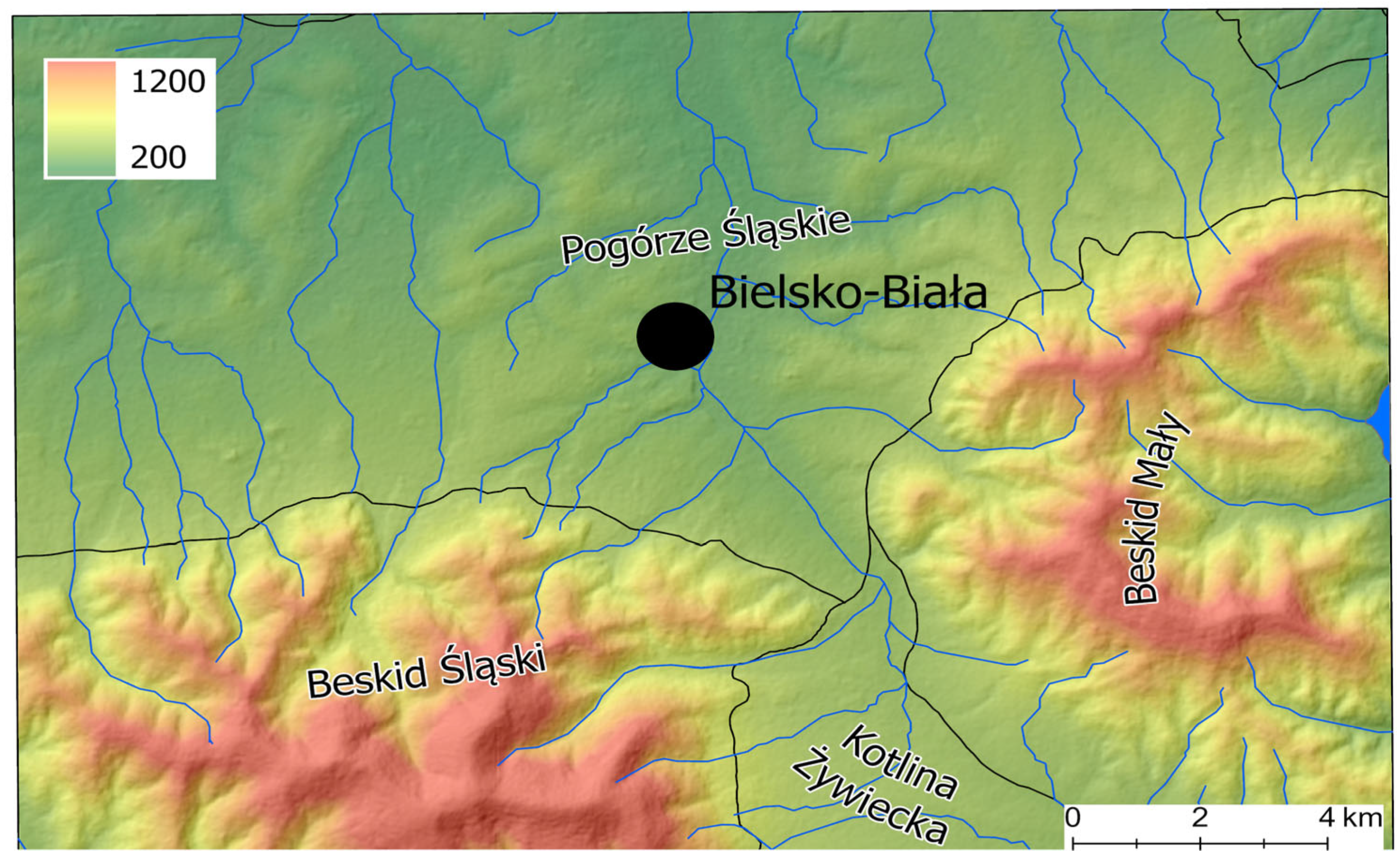
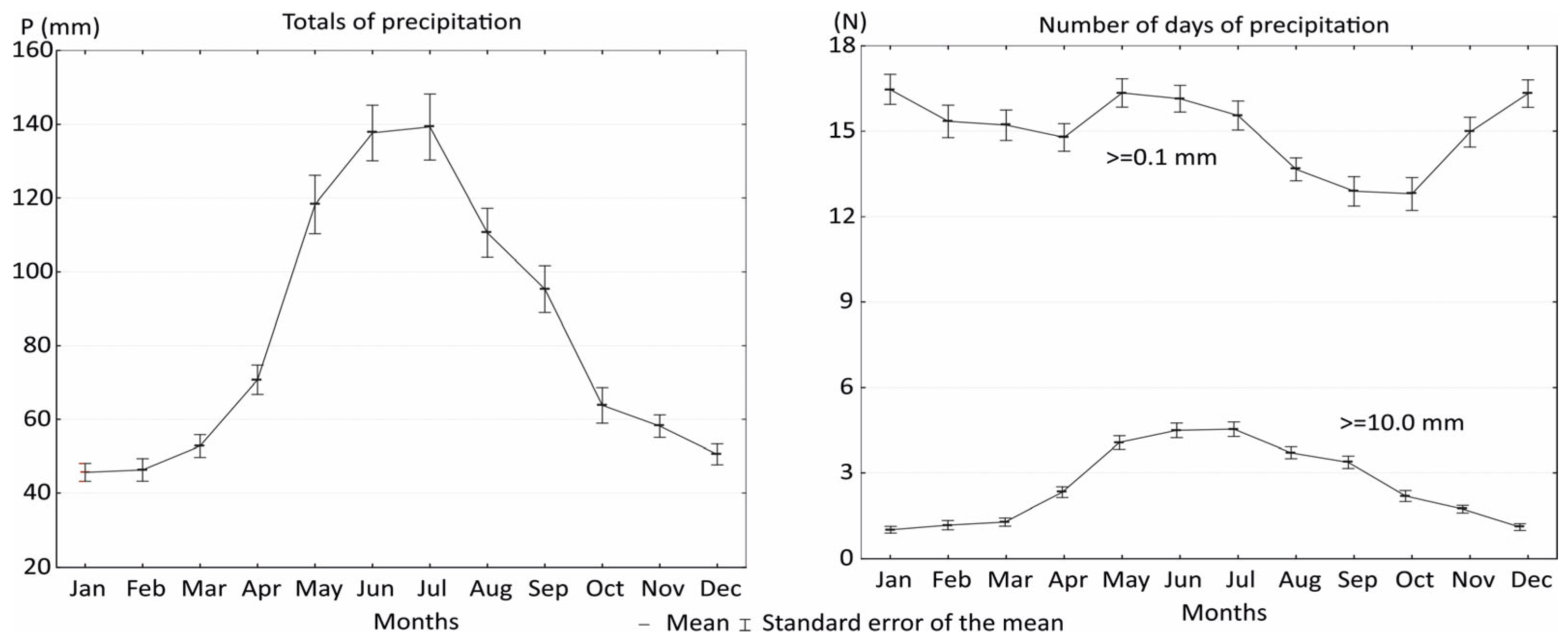
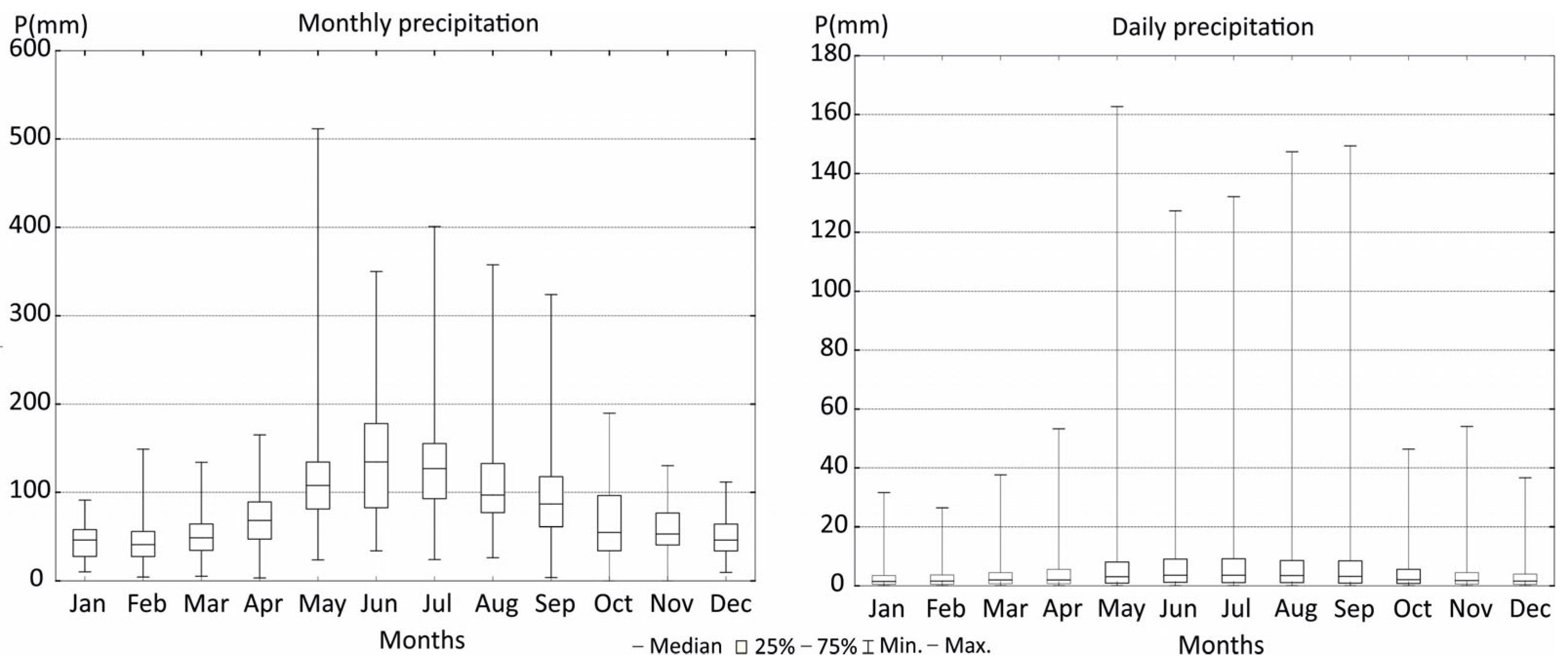
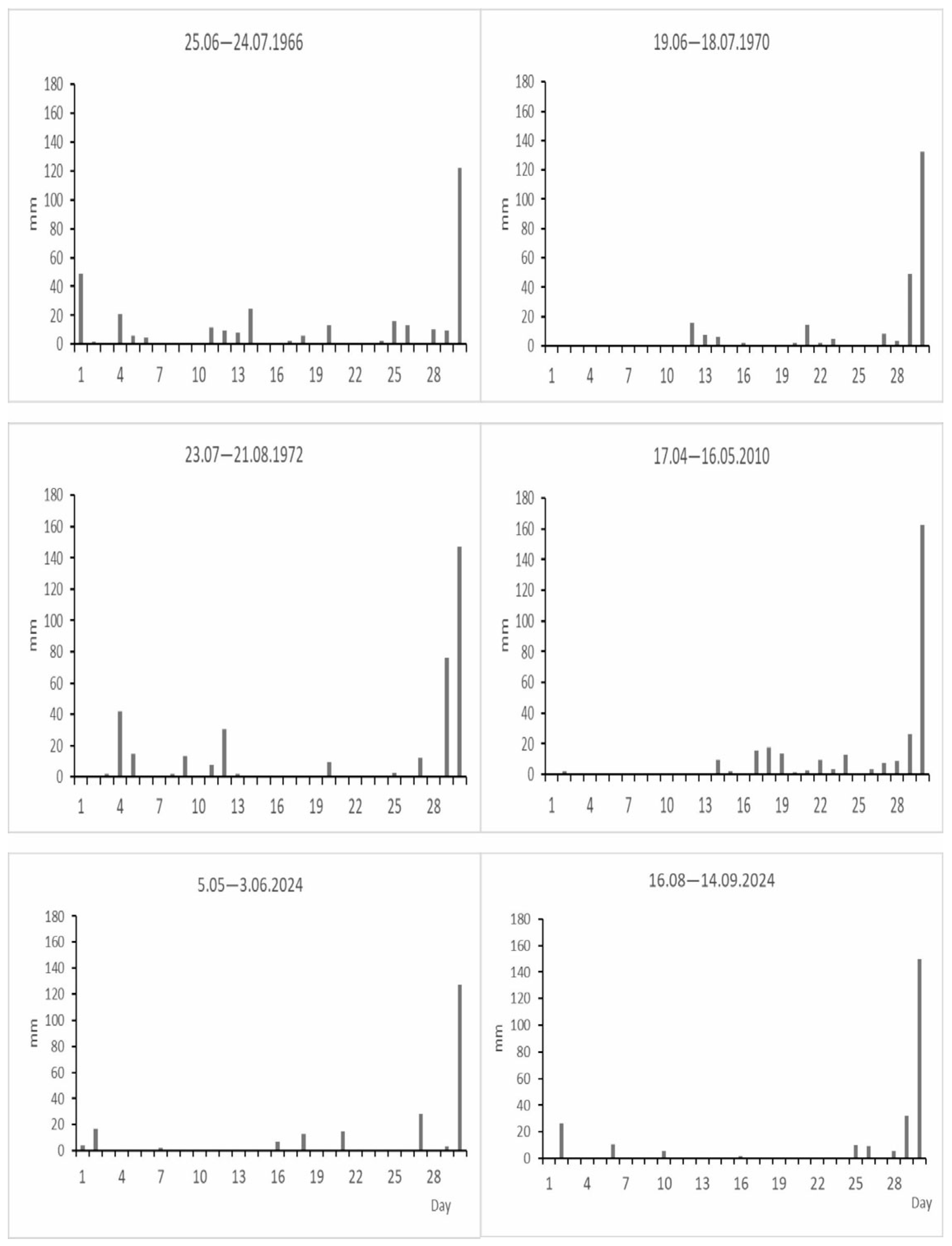
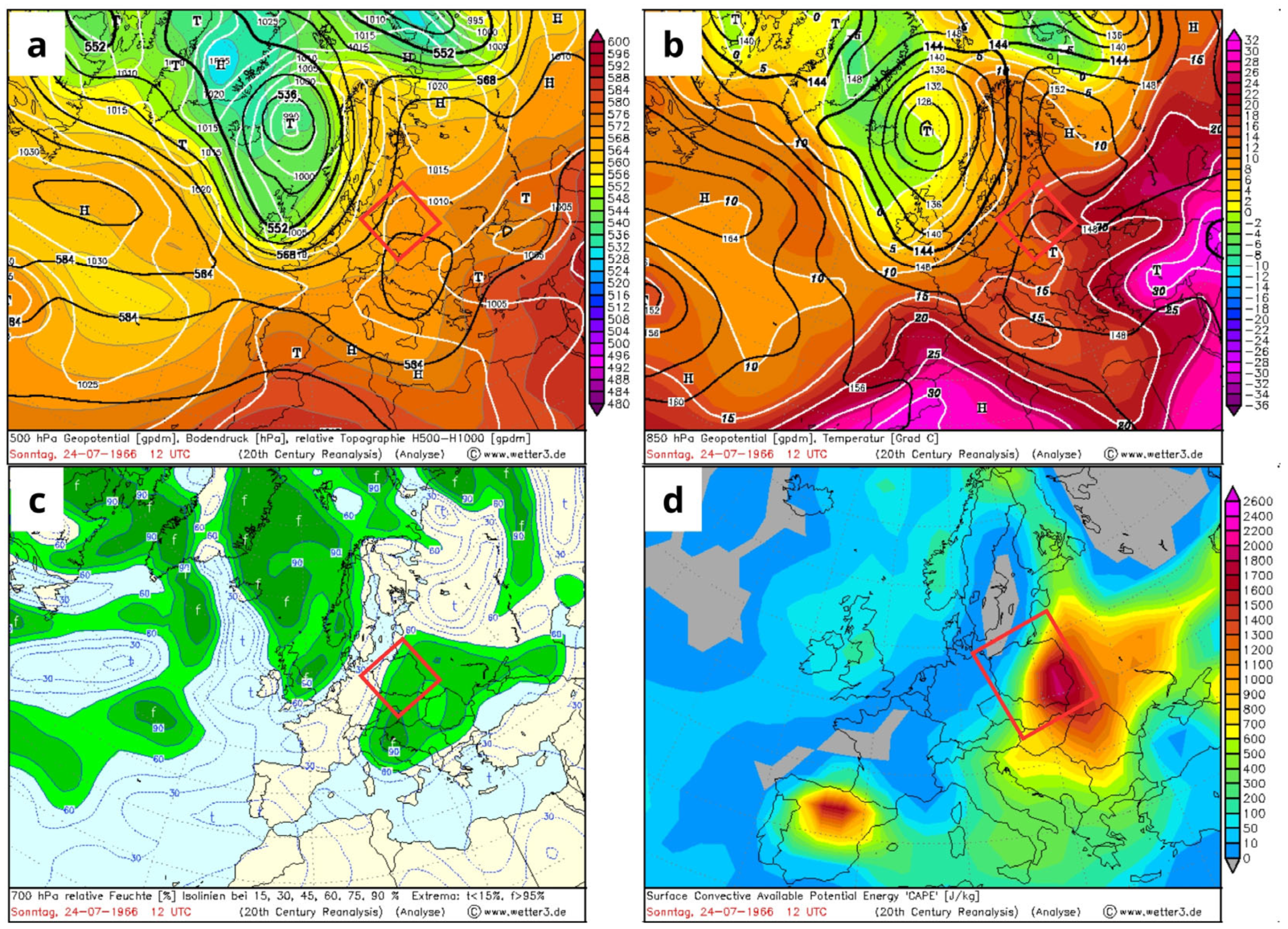
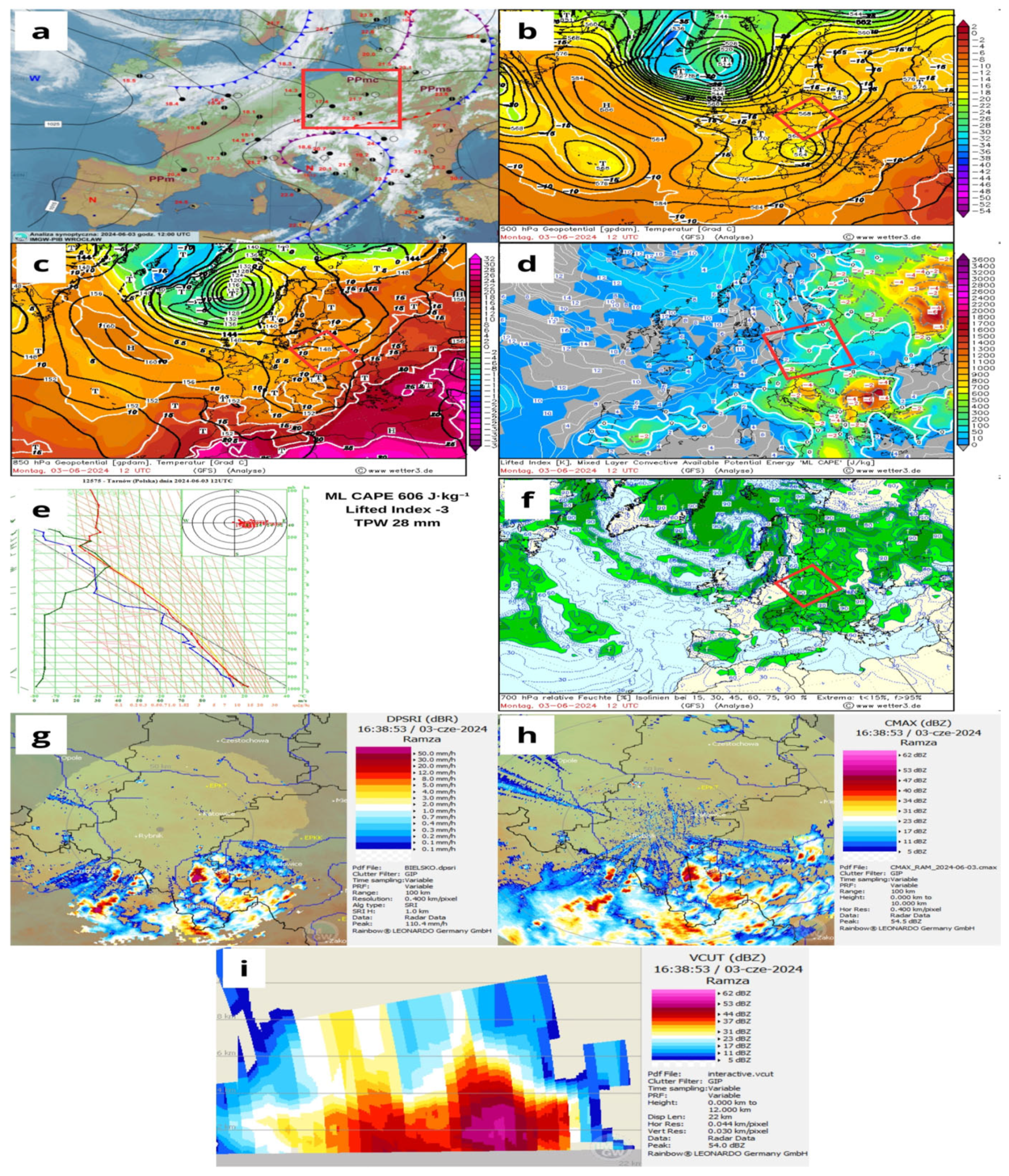

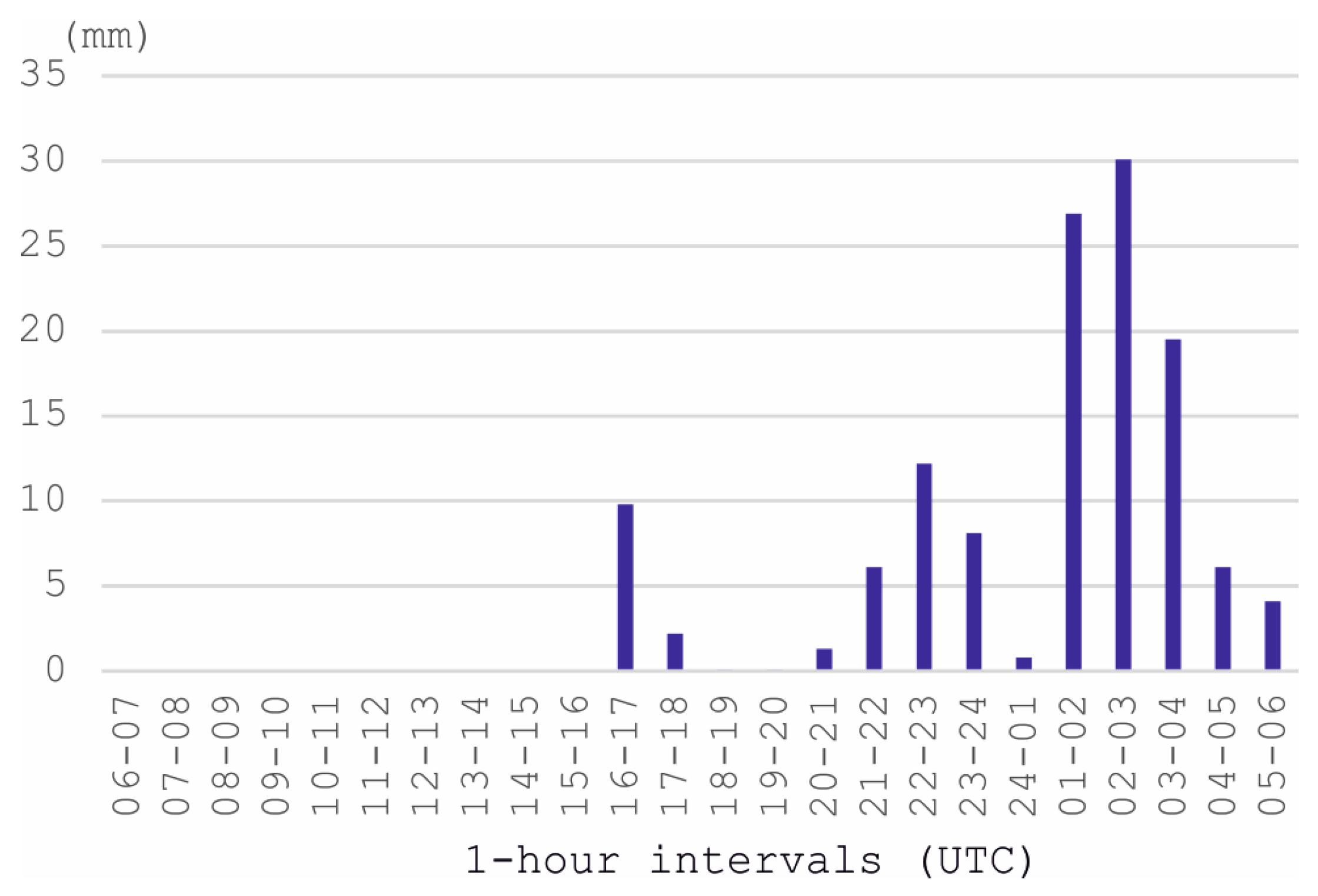
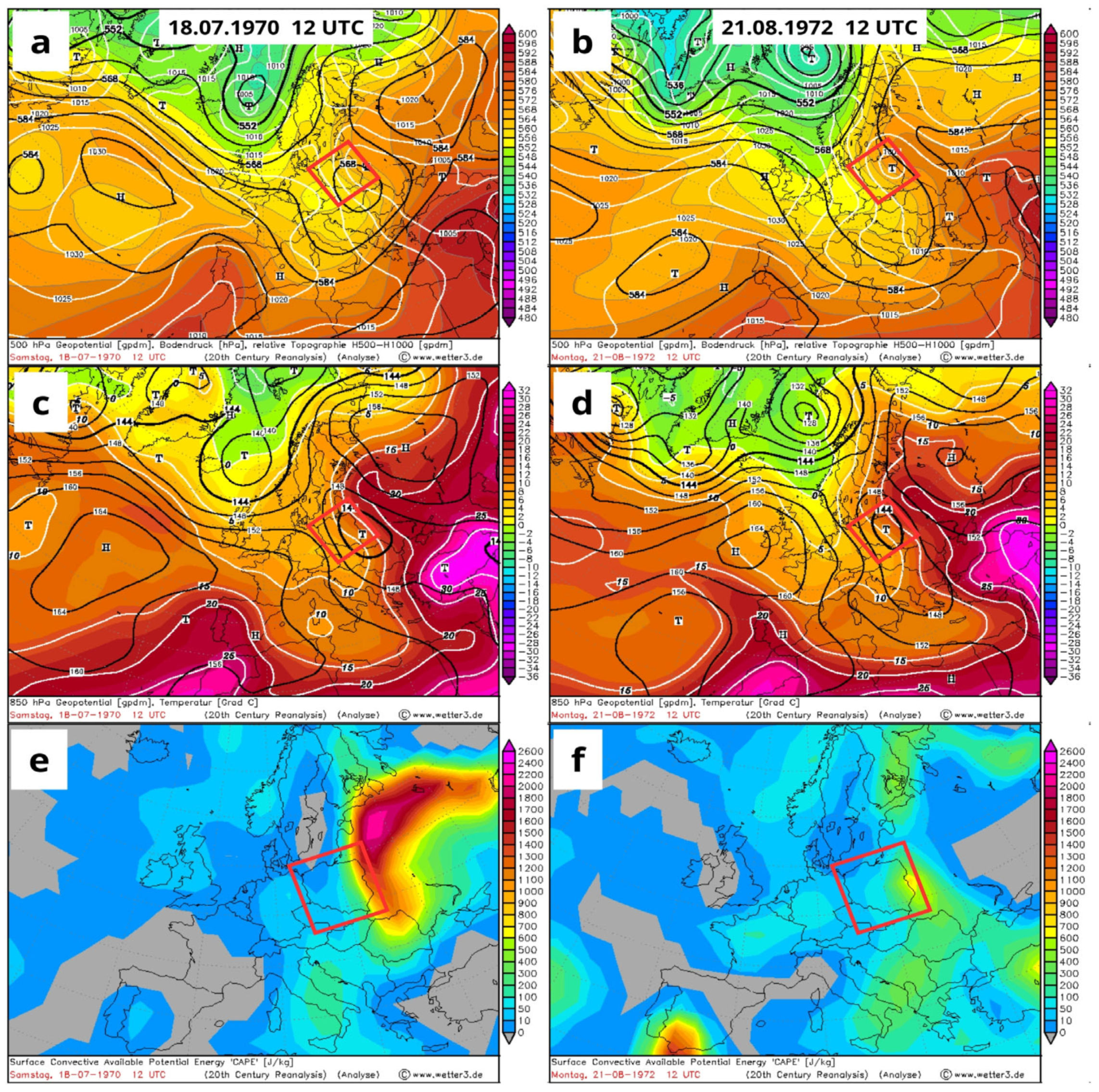
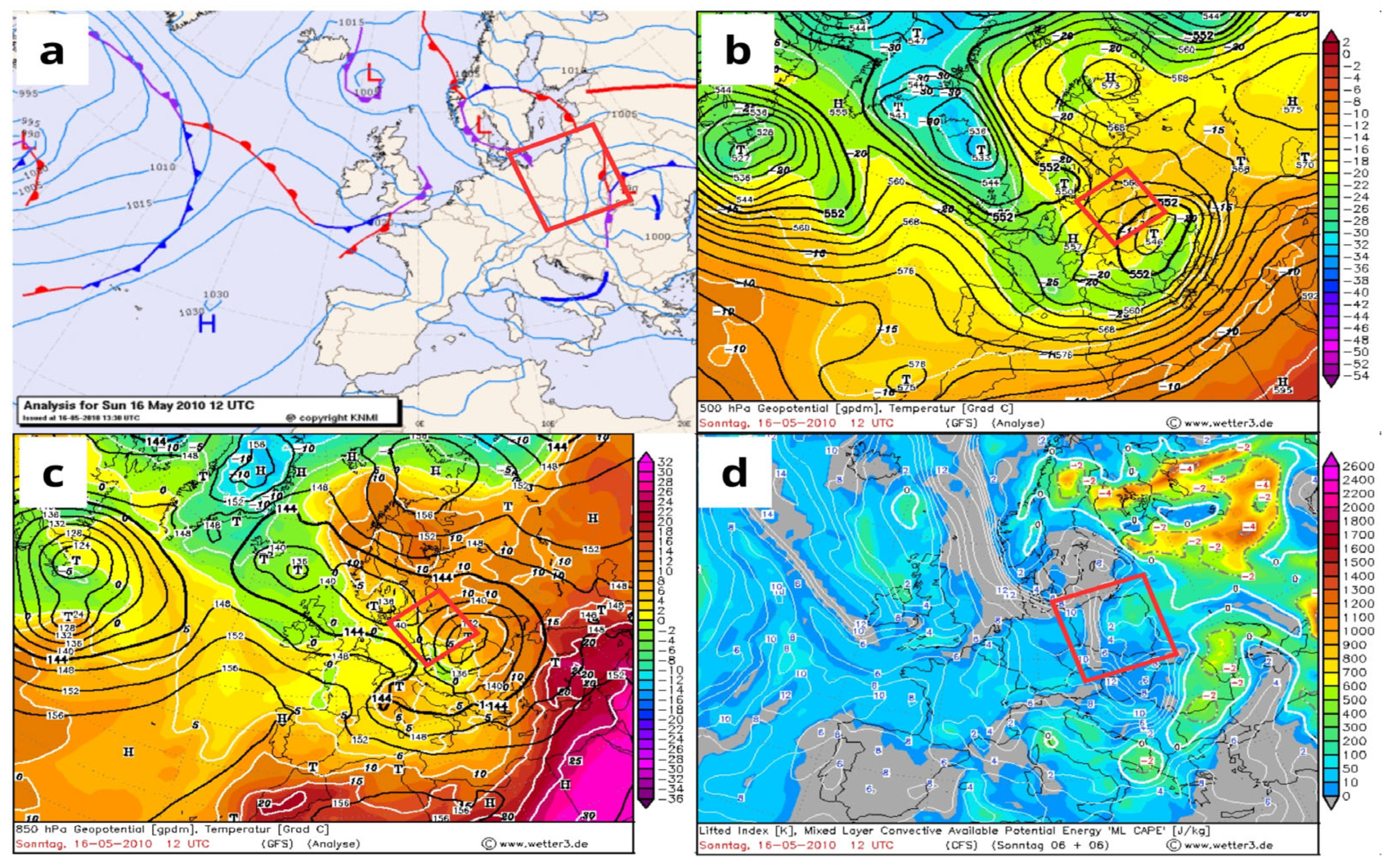

| No | Data | Totals (mm) | Empirical Probability p(m, N) (%) | Return Period (in Years) ** | Circulation Type * |
|---|---|---|---|---|---|
| 1. | 24 July 1966 | 122.2 | 6.7 | 15 | Bc (cyclonic trough) |
| 2. | 18 July 1970 | 132.1 | 5.3 | 19 | Nc (cyclonic from north) |
| 3. | 21 August 972 | 147.4 | 4.0 | 25 | Nc (cyclonic from north) |
| 4. | 16 May 2010 | 162.7 | 1.3 | 75 | NEc (cyclonic from north-east) |
| 5. | 3 June 2024 | 127.3 | 6.0 | 17 | NEc (cyclonic from north-east) |
| 6. | 14 September 2024 | 149.4 | 2.7 | 38 | NEc (cyclonic from north-east) |
| Months | 24 July 1966 | 18 July 1970 | 21 August 1972 | 16 May 2010 | 3 June 2024 |
|---|---|---|---|---|---|
| 14 September 2024 | |||||
| January | 0.32 | 0.38 | −0.35 | 0.50 | 0.67 |
| February | 1.49 | 0.08 | −0.32 | −0.09 | 0.94 |
| March | 1.51 | −0.60 | −1.76 | −1.15 | 0.28 |
| Aprl | 1.08 | 0.47 | 1.80 | 0.26 | 0.47 |
| May | 1.60 | −0.39 | −0.08 | 4.09 | −0.4 |
| June | 0.41 | 0.00 | −0.34 | 1.72 | |
| July | 2.49 | 1.74 | 0.43 | −1.84 | |
| August | 3.12 | −0.52 | |||
| September | 1.94 |
Disclaimer/Publisher’s Note: The statements, opinions and data contained in all publications are solely those of the individual author(s) and contributor(s) and not of MDPI and/or the editor(s). MDPI and/or the editor(s) disclaim responsibility for any injury to people or property resulting from any ideas, methods, instructions or products referred to in the content. |
© 2025 by the authors. Licensee MDPI, Basel, Switzerland. This article is an open access article distributed under the terms and conditions of the Creative Commons Attribution (CC BY) license (https://creativecommons.org/licenses/by/4.0/).
Share and Cite
Twardosz, R.; Guzik, I.; Cebulska, M. Catastrophic Precipitation in the City of Bielsko-Biała (Polish Carpathian Mountains) and Their Synoptic Circumstances (1951–2024). Water 2025, 17, 1611. https://doi.org/10.3390/w17111611
Twardosz R, Guzik I, Cebulska M. Catastrophic Precipitation in the City of Bielsko-Biała (Polish Carpathian Mountains) and Their Synoptic Circumstances (1951–2024). Water. 2025; 17(11):1611. https://doi.org/10.3390/w17111611
Chicago/Turabian StyleTwardosz, Robert, Izabela Guzik, and Marta Cebulska. 2025. "Catastrophic Precipitation in the City of Bielsko-Biała (Polish Carpathian Mountains) and Their Synoptic Circumstances (1951–2024)" Water 17, no. 11: 1611. https://doi.org/10.3390/w17111611
APA StyleTwardosz, R., Guzik, I., & Cebulska, M. (2025). Catastrophic Precipitation in the City of Bielsko-Biała (Polish Carpathian Mountains) and Their Synoptic Circumstances (1951–2024). Water, 17(11), 1611. https://doi.org/10.3390/w17111611






